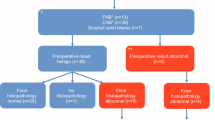Abstract
The incidence of breast lesions detected in reduction mammoplasty specimens varies with patients’ previous history of breast cancer, patients’ age, and the number of submitted pathological sections. The incidence of proliferative lesions with atypia including invasive carcinoma varies in different studies between 0.2% and 1.1%. In a retrospective review, 392 patients who underwent reduction mammoplasty mainly for symptomatic macromastia or breast symmetry were included in this study. All specimens of reduction mammoplasty were submitted for pathological examination and at least four tissue sections were taken for each breast. Among 392 patients, pathological examinations revealed proliferative lesions with atypia in 7 patients (1.7%) and invasive carcinoma in 1 patient (0.2%). Although proliferative lesions with atypia were found to increase in number compared with the patients under 40 years, there was no statistical significance found. Ductal in situ carcinoma was demonstrated in 1 patient (1%) younger than 40 years. Although there is no consensus formed for when to send mammoplasty specimens for pathological analysis or how many numbers of tissue sections to submit, we recommend routine pathological analysis of mammoplasty specimens and submitting at least four tissue sections regardless of patients’ age.
Similar content being viewed by others
References
Ambaye AB, MacLennan SE, Goodwin AJ, Suppan T, Naud S, Weaver DL (2009) Carcinoma and atypical hyperplasia in reduction mammoplasty: increased sampling leads to increased detection. A prospective study. Plast Reconstr Surg 124:1386–1392
American Society of Plastic Surgeons (2014) Reconstructive plastic surgery statistics. 2014. Available at: http://www.plasticsurgery.org/Documents/newsresources/statistics/2014-statistics/reconstructiveprocedure-trends-2014.pdf. Accessed 24 June 2015
American Society of Plastic Surgeons (2014) Cosmetic plastic surgery statistics. 2014. Available at: http://www.plasticsurgery.org/Documents/news-resources/statistics/2014-statistics/cosmetic-procedure-trends-2014.pdf. Accessed 28 Oct 2015
Carlson GW (2016) The management of breast cancer detected by reduction mammaplasty. Clin Plast Surg 43(2):341–347
Pitanguy I, Torres E, Salgado F, Pires Viana GA (2005) Breast pathology and reduction mammoplasty. Plast Reconstr Surg 115:729–734
Colwell AS, Kukreja J, Breuing KH, Lester S, Orgill DP (2004) Occult breast carcinoma in reduction mammoplasty specimens: 14-year experience. Plast Reconstr Surg 113:1984–1988
Slezak S, Bluebond-Langner R (2011) Occult carcinoma in 866 reduction mammaplasties: preserving the choice of lumpectomy. Plast ReconstrSurg 127:525–530
Ishag MT, Bashinsky DY, Beliaeva IV, Niemann TH, Marsh WL Jr (2003) Pathologic findings in reduction mammoplasty specimens. Am J ClinPathol 120:377–380
Freedman BC, Smith SM, Estabrook A, Balderacchi J, Tartter PI (2012) Incidence of occult carcinoma and high-risk lesions in mammoplasty specimens. Int J Breast Cancer 2012:145630
Dotto J, Kluk M, Geramizadeh B, Tavassoli FA (2008) Frequency of clinically occult intraepithelial and invasive neoplasia in reduction mammoplasty specimens: a study of 516 cases. Int J Surg Pathol 16:25–30
Clark CJ, Whang S, Paige KT (2009) Incidence of precancerous lesions in breast reduction tissue: a pathologic review of 562 consecutive patients. Plast Reconstr Surg 124:1033–1039
Fitzgibbons PL, Henson DE, Hutter RV (1998) Benign breast changes and the risk for subsequent breast cancer: an update of the 1985 consensus statement. Cancer Committee of the College of American Pathologists. Arch Pathol Lab Med 122:1053e5
Desouki MM, Li Z, Hameed O, Fadare O, Zhao C (2013) Incidental atypical proliferative lesions in reduction mammoplasty specimens: analysis of 2498 cases from 2 tertiary women’s health lefts. Hum Pathol 44(9):1877–1881
Merkkola-von Schantz PA, Jahkola TA, Krogerus LA, Hukkinen KS, Kauhanen SM (2017) Should we routinely analyze reduction mammaplasty specimens? J Plast Reconstr Aesthet Surg 70(2):196–202
Degnim AC, Winham SJ, Frank RD, Pankratz VS, Dupont WD, Vierkant RA, Frost MH, Hoskin TL, Vachon CM, Ghosh K, Hieken TJ, Carter JM, Denison LA, Broderick B, Hartmann LC, Visscher DW, Radisky DC (2018) Model for predicting breast cancer risk in women with atypical hyperplasia. J Clin Oncol 36(18):1840–1846
Hartmann LC, Radisky DC, Frost MH, Santen RJ, Vierkant RA, Benetti LL, Tarabishy Y, Ghosh K, Visscher DW, Degnim AC (2014) Understanding the premalignant potential of atypical hyperplasia through its natural history: a longitudinal cohort study. Cancer Prev Res (Phila) 7(2):211–217
McEvoy MP, Coopey SB, Mazzola E, Buckley J, Belli A, Polubriaginof F, Merrill AL, Tang R, Garber JE, Smith BL, Gadd MA, Specht MC, Guidi AJ, Roche CA, Hughes KS (2015) Breast cancer risk and follow-up recommendations for young women diagnosed with atypical hyperplasia and lobular carcinoma in situ (LCIS). Ann Surg Oncol 22(10):3346–3349
Author information
Authors and Affiliations
Corresponding author
Ethics declarations
This study was designed as a single left and retrospective study which was approved by the institutional review board.
Conflict of Interest
The authors declare that they have no conflict of interest.
Additional information
Publisher’s Note
Springer Nature remains neutral with regard to jurisdictional claims in published maps and institutional affiliations.
Rights and permissions
About this article
Cite this article
Balci, B., Salimoglu, S., Pala, E.E. et al. Incidental Lesions Detected in Reduction Mammoplasty Specimens. Indian J Surg 81, 572–575 (2019). https://doi.org/10.1007/s12262-019-01876-6
Received:
Accepted:
Published:
Issue Date:
DOI: https://doi.org/10.1007/s12262-019-01876-6




